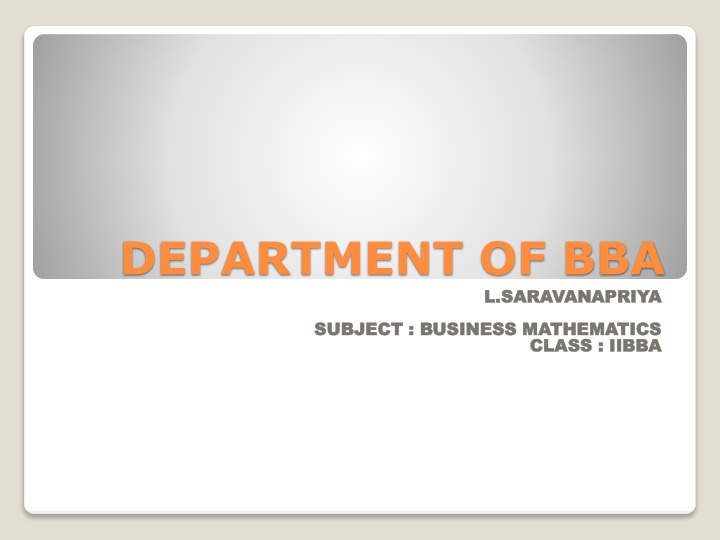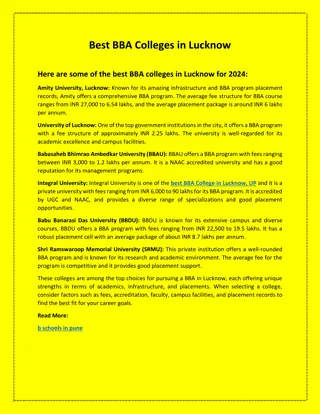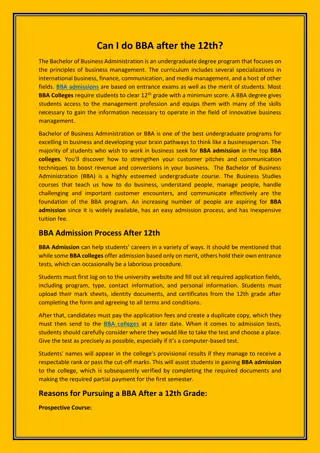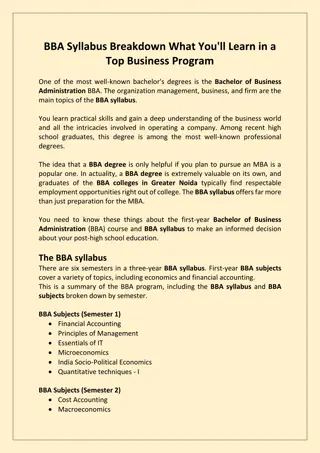DEPARTMENT OF BBA
Various types of sets in business mathematics including empty sets, finite sets, and infinite sets. Learn about cardinal numbers, equivalent sets, equal sets, and operations on sets like union and intersection. Enhance your understanding of fundamental concepts to apply in real-world scenarios.
Download Presentation

Please find below an Image/Link to download the presentation.
The content on the website is provided AS IS for your information and personal use only. It may not be sold, licensed, or shared on other websites without obtaining consent from the author.If you encounter any issues during the download, it is possible that the publisher has removed the file from their server.
You are allowed to download the files provided on this website for personal or commercial use, subject to the condition that they are used lawfully. All files are the property of their respective owners.
The content on the website is provided AS IS for your information and personal use only. It may not be sold, licensed, or shared on other websites without obtaining consent from the author.
E N D
Presentation Transcript
DEPARTMENT OF BBA L.SARAVANAPRIYA L.SARAVANAPRIYA SUBJECT : BUSINESS MATHEMATICS SUBJECT : BUSINESS MATHEMATICS CLASS : IIBBA CLASS : IIBBA
Types of Sets Empty Set or Null Set: A set which does not contain any element is called an empty set, or the null set or the void set and it is denoted by and is read as phi. In roster form, is denoted by {}. An empty set is a finite set, since the number of elements in an empty set is finite, i.e., 0. Singleton Set: A set which contains only one element is called a singleton set. For example: A = {x : x is neither prime nor composite}
Finite Set: A set which contains a definite number of elements is called a finite set. Empty set is also called a finite set. For example: The set of all colors in the rainbow. Infinite Set: The set whose elements cannot be listed, i.e., set containing never-ending elements is called an infinite set. For example: Set of all points in a plane A = {x : x N, x > 1}
Cardinal Number of a Set: The number of distinct elements in a given set A is called the cardinal number of A. It is denoted by n(A). For example: A {x : x N, x < 5} A = {1, 2, 3, 4} Therefore, n(A) = 4 Equivalent Sets: Two sets A and B are said to be equivalent if their cardinal number is same, i.e., n(A) = n(B). The symbol for denoting an equivalent set is . For example: A = {1, 2, 3} Here n(A) = 3 B = {p, q, r} Here n(B) = 3 Therefore, A B
Equal sets: Two sets A and B are said to be equal if they contain the same elements. Every element of A is an element of B and every element of B is an element of A. For example: A = {p, q, r, s} B = {p, s, r, q} Therefore, A = B
Operations on Sets The four basic operations are: 1. Union of Sets 2. Intersection of sets 3. Complement of the Set 4. Cartesian Product of sets
Union of Sets Union of two given sets is the smallest set which contains all the elements of both the sets. To find the union of two given sets A and B is a set which consists of all the elements of A and all the elements of B such that no element is repeated. The symbol for denoting union of sets is . For example; Let set A = {2, 4, 5, 6} and set B = {4, 6, 7, 8} Taking every element of both the sets A and B, without repeating any element, we get a new set = {2, 4, 5, 6, 7, 8} This new set contains all the elements of set A and all the elements of set B with no repetition of elements and is named as union of set A and B.
Intersection of Sets Intersection of two given sets is the largest set which contains all the elements that are common to both the sets. To find the intersection of two given sets A and B is a set which consists of all the elements which are common to both A and B. The symbol for denoting intersection of sets is . For example: Let set A = {2, 3, 4, 5, 6} and set B = {3, 5, 7, 9} In this two sets, the elements 3 and 5 are common. The set containing these common elements i.e., {3, 5} is the intersection of set A and B. The symbol used for the intersection of two sets is .
Complement of a Set In complement of a set if be the universal set and A a subset of , then the complement of A is the set of all elements of which are not the elements of A. Symbolically, we denote the complement of A with respect to as A . For Example; If = {1, 2, 3, 4, 5, 6, 7} A = {1, 3, 7} find A'. Solution: We observe that 2, 4, 5, 6 are the only elements of which do not belong to A. Therefore, A' = {2, 4, 5, 6}
Cardinal Number of a Set The number of distinct elements in a finite set is called its cardinal number. It is denoted as n(A) and read as the number of elements of the set . For example: (i) Set A = {2, 4, 5, 9, 15} has 5 elements. Therefore, the cardinal number of set A = 5. So, it is denoted as n(A) = 5. (ii) Set B = {w, x, y, z} has 4 elements. Therefore, the cardinal number of set B = 4. So, it is denoted as n(B) = 4.























